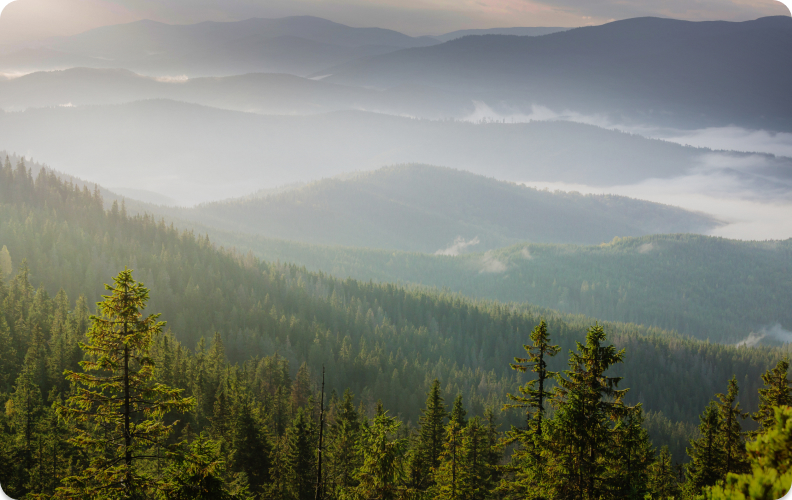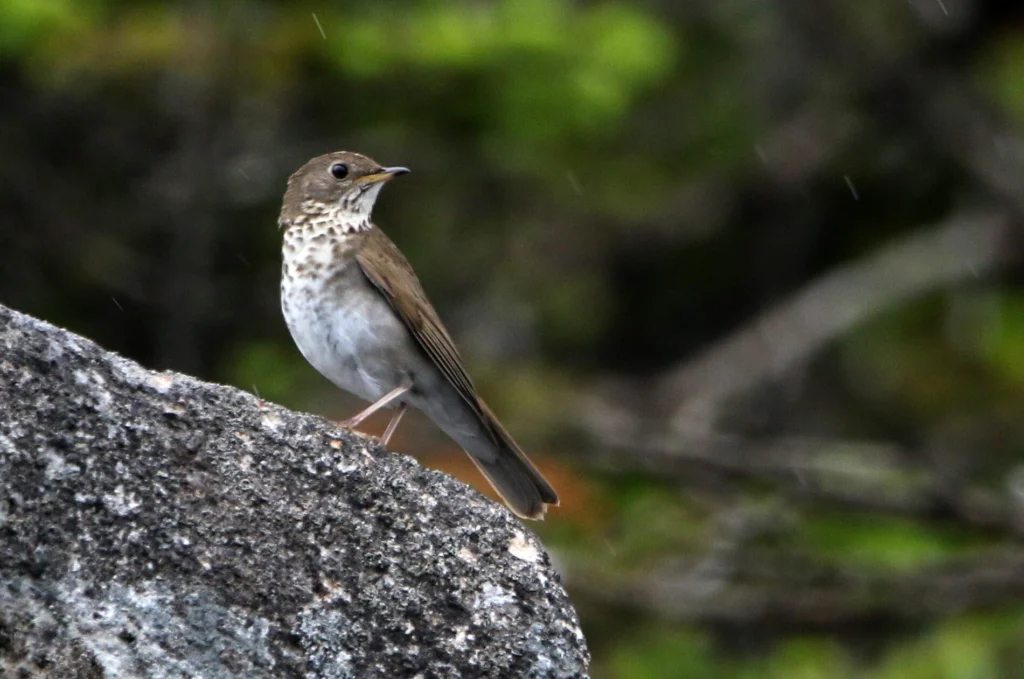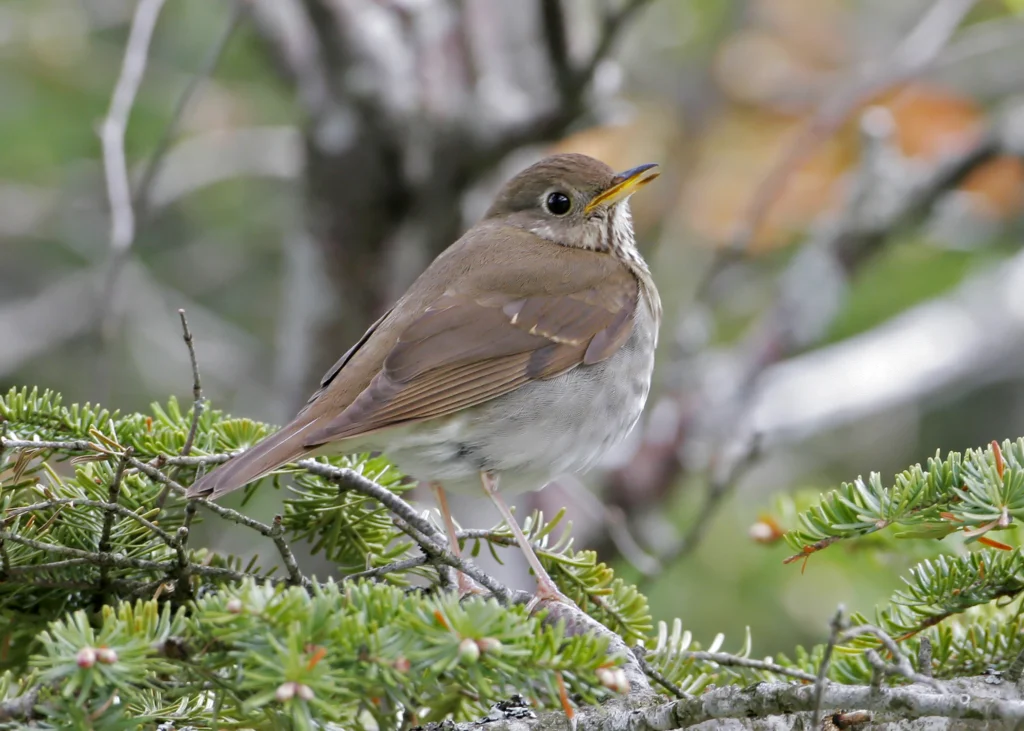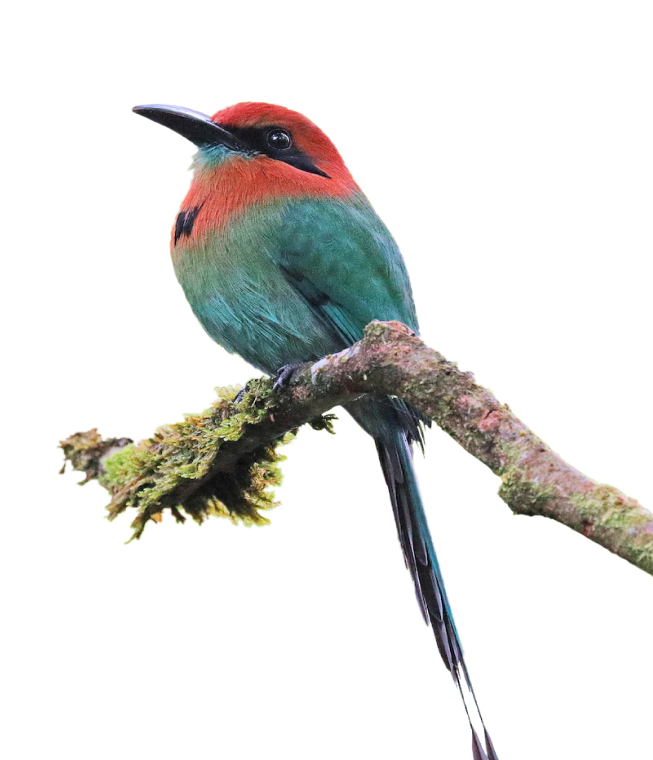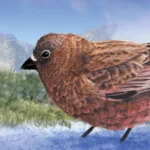
Overview
About
The elusive Bicknell’s Thrush was once considered an isolated population of the Gray-cheeked Thrush. Then, in 1995, ornithologists decided that differences in plumage, size, song, and range warranted splitting the two into distinct species. Distinguishing the two is no easy task — they’re best identified by their songs, but the shy and furtive Bicknell’s Thrush is not always very vocal. Unlike other, more colorful and common thrushes such as the Mountain Bluebird and American Robin, the Bicknell’s Thrush is seldom seen. It’s most often glimpsed on its remote nesting grounds.
The Bicknell’s Thrush is discerning when it comes to nesting, needing trees of a specific species within a certain age range throughout much of its breeding range. As a habitat specialist that requires specific forest conditions, this thrush recalls the Kirtland’s Warbler, a bird that has been rebounding thanks to conservation on working lands that ensure large areas of young pine forest remain for this bird. A similar marriage between carefully orchestrated forestry practices and conservation would likely benefit the Bicknell’s Thrush, particularly in Canada’s Maritime Provinces.
Threats
With a small breeding range, specific habitat requirements, and an even smaller nonbreeding range in the Caribbean, the Bicknell’s Thrush is up against significant challenges caused by habitat loss and climate change.
Habitat Loss
Unsustainable timber thinning and harvesting, forest clearance for tower and turbine construction, and air pollution are all leading to fragmentation and habitat loss on the Bicknell’s Thrush breeding grounds in pockets of the northeastern U.S. and Canada. In the Caribbean, the thrush’s nonbreeding habitat is lost to agricultural conversion, logging, and charcoal production.
Climate Change
As the climate warms, the Bicknell’s Thrush stands to lose portions of the high-elevation spruce and fir forests it relies on for breeding.
Wind Turbines
Like other migrating birds, the Bicknell’s Thrush faces potentially deadly collisions with communications towers and poorly sited wind turbines, which are often placed atop mountain ridges where this bird may nest.
Conservation Strategies & Projects
Birds like the Bicknell’s Thrush need our help to overcome the threats they face. As a habitat specialist at risk of losing its nesting grounds to development and climate change, the thrush will almost certainly require conservation action to rebound.
At ABC, we’re inspired by the wonder of birds and driven by our responsibility to find solutions to meet their greatest challenges. With science as our foundation, and with inclusion and partnership at the heart of all we do, we take bold action for birds across the Americas.
Creating & Maintaining Reserves
Since 2004, ABC has been improving management of Sierra de Bahoruco National Park in the Dominican Republic, an important area for the Bicknell’s Thrush in the nonbreeding season. This mountainous range is also home to the Endangered Black-capped Petrel, Bay-breasted Cuckoo, and Hispaniolan Crossbill.
ABC and our in-country partners have improved training for park guards and engaged the local community in park protection. Together, we’re working to restore deforested areas and further research on the Bicknell Thrush’s nonbreeding habitats.
Protecting Migration
We work at a landscape scale to protect migratory birds like the Bicknell’s Thrush throughout their full annual cycles, from breeding to nonbreeding grounds, and the stopover habitats they need in between.
Rethinking Wind Turbines
ABC supports Bird-Smart wind energy. Our wind risk assessment map helps to identify the most sensitive areas for bird migration — places where wind projects would pose an increased risk for birds — and enables project planners to find more suitable, safer locations.
Preventing Glass Collision
In addition to threats from poorly sited wind turbines, the Bicknell’s Thrush is prone to collisions with windows. ABC’s Collisions program tests and evaluates solutions for window collisions for buildings of all kinds and supports bird-friendly building ordinances in municipalities across the U.S.
Bird Gallery
A slender, medium-sized thrush boasting a chest dotted with bold, brown spots, the Bicknell’s Thrush at first glance looks like any of the five North American thrushes in the genus Catharus. And even with subsequent glances, it can be tough to tell these thrushes apart! They all require careful observation for reliable identification in the field, but the Bicknell’s and Gray-cheeked Thrushes are the most challenging to tell apart: They are “nearly identical” and “reliably distinguished only by voice,” according to David A. Sibley in his field guide.
A key difference between the Bicknell’s and Gray-cheeked Thrushes is the subtle wash of chestnut color on the Bicknell’s wings and tail, but this field mark is often difficult to see.
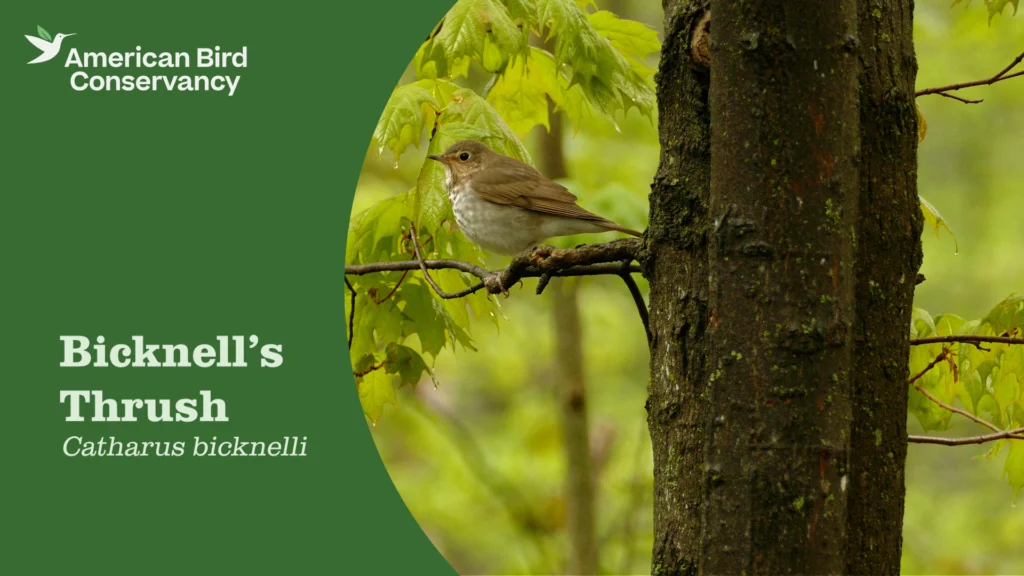
Bird Sounds
The Bicknell’s Thrush song is a wiry, downslurring series of notes with a rising final note at the end. Its most commonly heard call is a sharp, downslurring whistle, beer.
Both sexes of Bicknell’s Thrush sing, although the male is the most often heard.
Rolf A. de By, XC469600. Accessible at www.xeno-canto.org/469600.
Will Sweet, XC501697. Accessible at www.xeno-canto.org/501697.
Habitats
Although generally known as a “forest bird,” the Bicknell’s Thrush has specific habitat needs for nesting that vary across its small and scattered breeding range, and it doesn’t nest in the forest interior. It breeds in mountainous pockets of four states in the northeastern U.S., and in hilly, coastal terrain in three provinces in Canada.
- Favors forest edges created by natural disturbances or certain types of human-caused clearing (such as ski runs and timber harvests) for nesting
- In many breeding areas, requires a thick undergrowth of balsam firs whose growth is spurred by sunlight reaching the ground level after the forest canopy is opened up by events like blowdowns, ice buildups, and clear cuts of adjacent, taller forests
- Spends the nonbreeding season in broadleaf and second-growth mountain forests
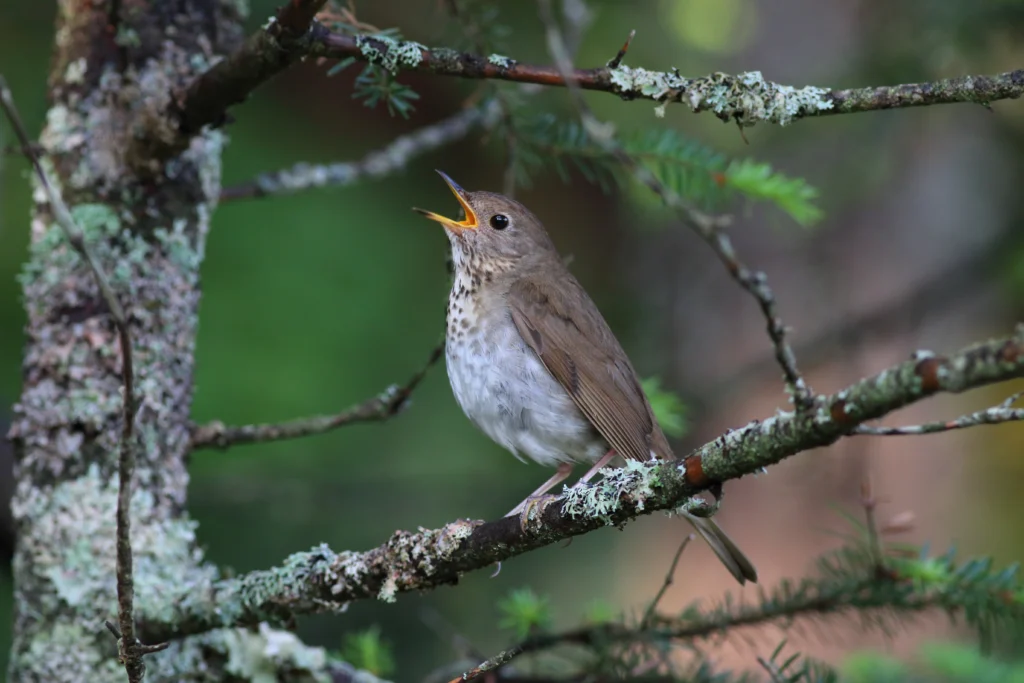
Range & Region
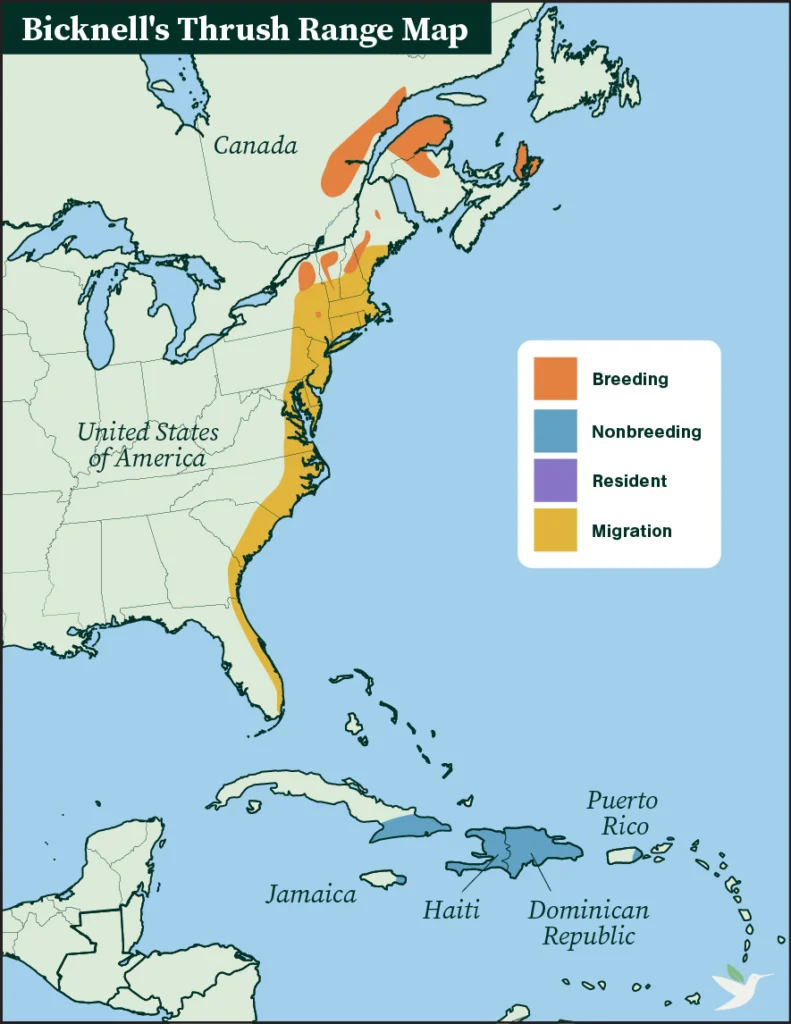
Specific Area
Northeastern United States and the Caribbean – New York, Vermont, New Hampshire, and Maine in the U.S.; Quebec, New Brunswick, and Nova Scotia in Canada; Dominican Republic, Haiti, Jamaica
Range Detail
The Bicknell’s Thrush has a spotty breeding range in the Northeast, nesting in some mountainous pockets in four U.S. states — New York, Vermont, New Hampshire, and Maine — and hilly and coastal terrain in parts of three Canadian provinces — Quebec, New Brunswick, and Nova Scotia.
Not often seen during migration, the Bicknell’s Thrush spends the nonbreeding season in parts of the Caribbean, with its stronghold in the Dominican Republic. It also occurs in next-door Haiti, although less habitat remains there, and in eastern Jamaica, eastern Cuba (rare), and Puerto Rico (rare). With the nonbreeding range even smaller than the nesting range, land use decisions on these islands can have an outsize impact on this Neotropical songbird. On the nonbreeding grounds, males are often found at higher elevations than females.
Did you know?
Although Bicknell’s Thrushes are seldom observed in migration — due in part to the difficulty of identifying the birds by sight alone — the use of geolocators has shown that the species’ migration north and south takes place entirely to the east of the Appalachian Mountains.
Life History
The Bicknell’s Thrush has a somewhat uncommon mating system: Males and females both take multiple partners, resulting in males sometimes simultaneously feeding more than one brood containing offspring from several fathers. Males sing from a home range that overlaps with those of other males, rather than defending their territories, but females will chase off other females.
Diet
Like many migratory songbirds, the Bicknell’s Thrush consumes protein-rich insects, including beetles, ants, and caterpillars, during its breeding season, then adds small fruits and berries to its diet during migration and on its nonbreeding grounds. It usually forages on or close to the ground, scratching, hopping, and making short, low flights to secure its prey. It will also dart into the air after flying insects.
Courtship
Male Bicknell’s Thrushes arrive back on breeding grounds shortly before females return. By late May and the first week of June, males begin courting females. Males will sometimes sing as they pursue females through thickets, and perch with wings drooped and fluttering to initiate mating.
Nesting
The female builds the nest, usually placing it low and close to the trunk of a young tree, often a fir, at or close to the edge of the forest. There, she weaves together a cup of twigs and mosses, then lines her construction with softer materials, including decomposing leaves, stringy horsehair fungus, and grasses and other pliable vegetation.
Eggs & Young
The female Bicknell’s Thrush lays three to four blue-green eggs dappled with brown, which she alone incubates for up to two weeks. After the nestlings hatch, parents share the duties of bringing them food, often with multiple males feeding nestlings, including those that are not their offspring. Fledging occurs when the young birds are nine to 13 days old.
